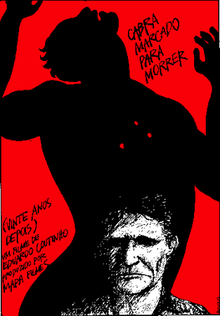Twenty Years Later
| Twenty Years Later | |
|---|---|
 Theatrical release poster | |
| Directed by | Eduardo Coutinho |
| Produced by |
Eduardo Coutinho Zelito Viana |
| Written by | Eduardo Coutinho |
| Narrated by |
Ferreira Gullar Tite de Lemos |
| Music by | Rogério Rossini |
| Cinematography |
Edgar Moura Fernando Duarte |
| Edited by | Eduardo Escorel |
Production company |
Mapa Filmes |
| Distributed by | Gaumont |
Release dates |
|
Running time | 119 minutes |
| Country | Brazil |
| Language | Portuguese |
Twenty Years Later (Portuguese: Cabra Marcado para Morrer) is a 1984 Brazilian documentary film directed by Eduardo Coutinho. One of the most known films by Coutinho, it started to be produced in 1964. However, due to the theme it dealt part of crew and cast were arrested and the police tried to take their footage. In 1984, Coutinho concluded the story of João Pedro Teixeira, a leader of the Peasant leagues from Paraíba, murdered by local landowners' order in 1962. Upon its release, it gained a cult following as well as received awards at film festivals and praise by film critics.
Overview
It tells the story of João Pedro Teixeira, a peasant leader from Sapé, Paraíba, who was murdered in 1962 on the order of local landowners.[2][3]
In 1962, Coutinho, replacing a cameraman of Centro Popular de Cultura (CPC), shot a protest over the death of Teixeira in Paraíba and met for the first time Elizabeth, Teixeira's widow.[2] When he returned to Rio de Janeiro, he received the proposal of directing a film for CPC.[2] Initially he wanted to adapt the João Cabral de Melo Neto's poems "Cão sem plumas", "O rio" and "Vida e morte Severina" but after the refusal of the poet he decided to film the life of Texeira.[4] In 1963, he went to Paraíba and Pernambuco and within three days he wrote a screenplay based on Mrs. Teixeira's accounts.[4]
Coutinho started to shot the film in 1964, and to be more authentic, he cast Mrs. Teixeira as herself, and other farmers in the other roles.[5] He wanted to film in Sapé but because of local conflicts he moved the filming location to Vitória de Santo Antão, Pernambuco.[4] However, after 35 days,[4] and with about 40 percent of the film complete, the Brazilian military dictatorship arrested some members of cast and crew for being politically dangerous.[3][5] The government tried to confiscate its footage, but Coutinho was able to keep it.[5]
Returning to the region where Twenty Years later was shot to produce other documentaries in 1979, Coutinho thought about resuming the film.[6] He also concluded he needed to make a different kind of project, and that he and all the crew of the 1964 film would feature on it.[7] In 1984, he showed what he had filmed to Mrs. Teixeira and local people and documented their reactions to it and the changing times.[8]
Reception
In 1984, at the 6th Havana Film Festival, Twenty Years Later won the Best Documentary Award.[9] It won the Best Film Award at the 1st Festroia International Film Festival and at the 1985 Cinéma du Réel.[10][11] Moreover, it became one of the best known films by Coutinho. It gained a cult following in Brazil,[12] and the section In Memoriam of the 86th Academy Awards used it as a reference of his career.[13]
By the time it was released in the English-speaking world it was also well received by its critics. Variety "It became a historical document of the revolution from the losers' viewpoint. Cabra suggest the cinema's power to be an agent of its own creative process. It is a highly original documentary".[8] The New York Times described it as "a provocative, one-of-a-kind document" that "is anything but idyllic. However, Mr. Coutinho's commitment to his characters is all the more effective for being cool, controlled and unsentimental."[3] Johh King, in his book Magical Reels: A History of Cinema in Latin America called it "The most important Brazilian documentary of the period".[8] Writing for RogerEbert.com, Pablo Villaça praised its "fascinating narrative" and deemed it as "one of the most intriguing documentaries you could ever see".[5]
References
- ↑ "Cabra Marcado para Morrer" (in Portuguese). Cinemateca Brasileira. Retrieved April 26, 2014.
- ↑ 2.0 2.1 2.2 Lins 2004, p. 36.
- ↑ 3.0 3.1 3.2 "Film: '20 Years Later'". The New York Times. The New York Times Company. May 12, 1985. Retrieved April 26, 2014.
- ↑ 4.0 4.1 4.2 4.3 Lins 2004, p. 37.
- ↑ 5.0 5.1 5.2 5.3 Villaça, Pablo (February 2, 2014). "Broken Screens: Eduardo Coutinho, 1933–2014". RogerEbert.com. Retrieved April 26, 2014.
- ↑ Berciano, Rosa Álvarez (December 5, 1986). "'Cabra, marcado para morir', filme sobre el campesino brasileño". El País (in Spanish). Retrieved December 15, 2014.
- ↑ Lins 2004, p. 38.
- ↑ 8.0 8.1 8.2 "Cabra Marcado Para Morrer" (PDF). Cannes Film Festival. Retrieved April 26, 2014.
- ↑ "Premios 6ta Edición del Festival Internacional del Nuevo Cine Latinoamericano" (in Spanish). Havana Film Festival. Archived from the original on April 22, 2014. Retrieved December 15, 2014.
- ↑ "Prêmios | Golfinhos de Ouro" (in Portuguese). Festroia International Film Festival. Retrieved April 26, 2014.
- ↑ "Hommage à Eduardo Coutinho" (in French). Cinéma du Réel. Retrieved April 26, 2014.
- ↑ Merten, Luiz Carlos (September 19, 2012). "'Cabra Marcado para Morrer' ganha versão restaurada". O Estado de S. Paulo (in Portuguese). Grupo Estado. Retrieved April 26, 2014.
- ↑ "Cineasta Eduardo Coutinho é homenageado no Oscar". Zero Hora (in Portuguese). Grupo RBS. March 3, 2014. Retrieved April 26, 2014.
- Bibliography
- Lins, Consuelo (2004). O documentário de Eduardo Coutinho: televisão, cinema e vídeo (in Portuguese). Zahar. pp. 36–38. ISBN 9788571107694.
External links
| ||||||||||||||||||